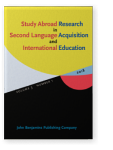Vol. 3:1 (2018) ► pp.1–31
Vol. 3:1 (2018) ► pp.1–31
Aptitude measures in SLA
Aptitude and achievement measures as predictors of growth in second language proficiency
The present study examines a US Department of Defense (DOD) foreign language program using linear and logistic regression to model foreign language proficiency growth over three time intervals. The analysis demonstrates growth from start to finish for a program involving domestic immersion and study abroad and tests the ability of aptitude and achievement measures to predict that growth for a group of 80 students. The findings suggest that a measure of foreign language aptitude and a measure of quantitative aptitude differentiate learning outcomes for the intensive domestic immersion portion of the program while measures of quantitative aptitude and native language verbal aptitude differentiate later-stage learners on the study abroad portion of the program.
Article outline
- 1.Introduction
- 2.Literature review
- 3.Methodology
- 3.1Participants
- 4.Analysis of proficiency outcomes at the end of the domestic immersion program
- 4.1Participants
- 4.2Results
- 4.2.1DLI GPA outcome analysis
- 4.2.2End of instruction at DLI reading DLPT outcome analysis
- 4.2.3End of instruction at DLI listening DLPT outcome analysis
- 4.2.4End of instruction at DLI oral proficiency interview (OPI) outcome analysis
- 4.3Discussion
- 5.Analysis of proficiency change during study abroad
- 5.1Participants
- 5.2Listening model results
- 5.3Reading model results
- 5.4Discussion
- 6.Discussion and conclusions
- Note
-
References
